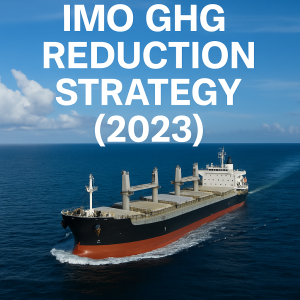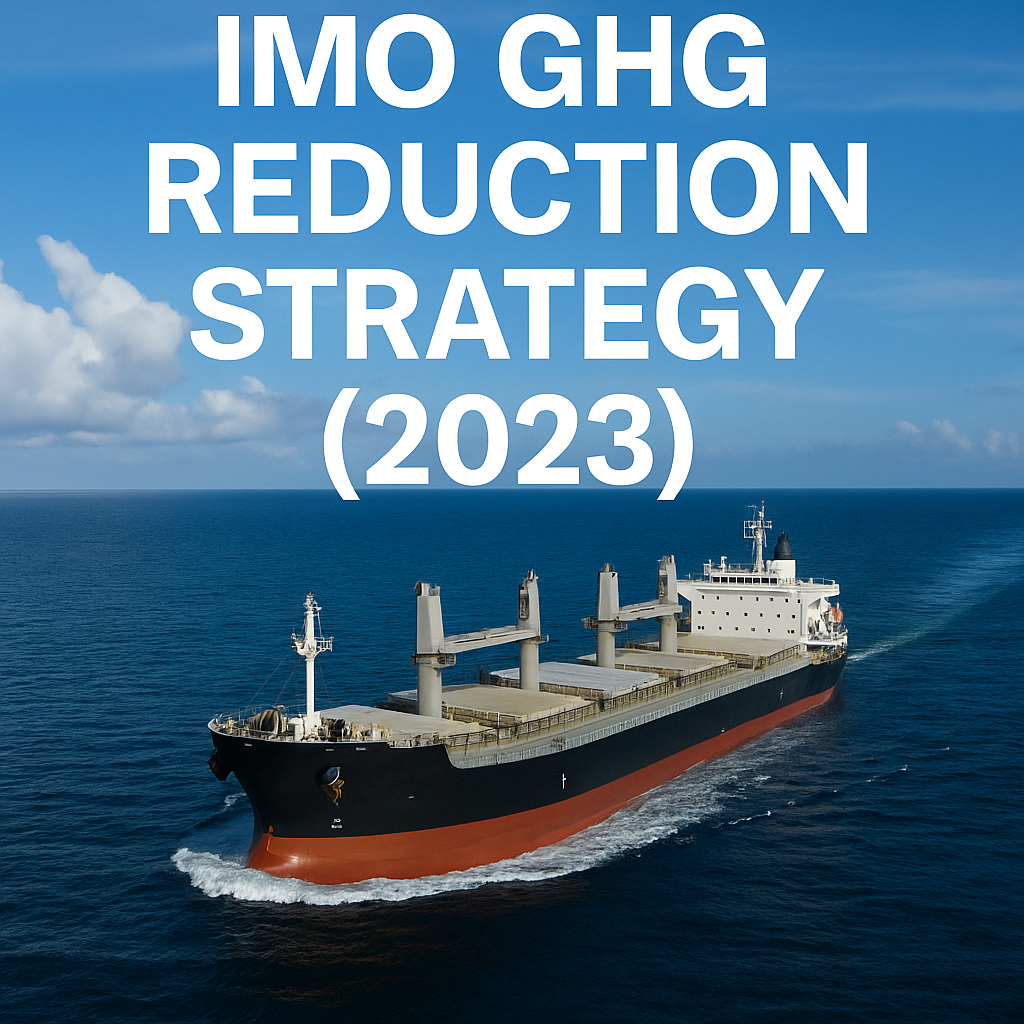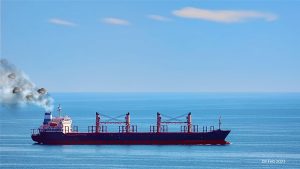Discover the 10 most significant updates in the IMO’s 2023 GHG reduction strategy for shipping. Learn new targets, timelines, fuel standards, and market-based measures transforming maritime decarbonization.

Why the 2023 GHG Strategy Is a Game-Changer
International shipping contributes nearly 3% of global greenhouse gas emissions—more than many countries. In July 2023, the International Maritime Organization (IMO) significantly strengthened its environmental roadmap, replacing the less ambitious 2018 plan with a more robust 2023 GHG Strategy.This updated framework now sets clear reduction milestones, life-cycle emissions criteria, and introduces support mechanisms for developing nations.
As regulators, shipowners, and professionals worldwide grapple with decarbonization, understanding these top 10 updates is essential to help shape strategies, investments, and operational decisions in the next decades.
1. Stronger Ambition with Enhanced 2030, 2040, and 2050 Targets
IMO sharpened its ambition:
-
At least 40% reduction in carbon intensity (CO₂ emissions per transport work) by 2030 versus 2008.
-
5–10% adoption of zero or near-zero emission fuels by 2030, assessed on a well-to-wake basis.
-
Emissions must peak soon and reach net-zero “around 2050”, aligning more with the Paris goals.
These revised benchmarks reflect the accelerated urgency needed in global shipping.
2. Indicative Checkpoints for 2030 and 2040
To track progress:
-
20–30% absolute reduction in GHG emissions by 2030 relative to 2008.
-
70–80% reduction by 2040.
While framed as “indicative checkpoints” rather than legally binding targets, they serve as benchmarks for 2028 strategy reviews.
3. Well-to-Wake (WtW) Emissions Assessment
The strategy now emphasizes well-to-wake accounting—tracking GHG emissions from fuel production through combustion onboard.
This pushes for truly clean solutions—like green ammonia—over transitional options like LNG, whose upstream emissions may undermine climate benefits.
4. Net-Zero “By or Around 2050”
The updated vision sets net-zero GHG emissions by or around 2050, a vital shift toward Paris-aligned decarbonization—but the flexible wording has sparked debate.
5. Candidate Mid-Term Measures Timeline
The strategy outlines a pipeline of regulatory steps:
-
Impact assessments and proposals through 2024.
-
Approval of mid-term measures by MEPC83 (Spring 2025).
-
Entering into force by ~2027–2028.
This marks a shift from ambition to implementation.
6. Life-Cycle-Based Fuel Incentives & Pricing
Proposals include:
-
GHG Fuel Standard (GFS) requiring minimum fuel performance over life-cycle emissions.
-
Feebate schemes: carbon levies on polluting fuels, rebates for zero-GHG ones.
-
Market exchange: vessels exceeding compliance earn units; those underperforming pay.
This sturdy economic mechanism encourages clean fuel adoption.
7. Technical Cooperation, Capacity‑Building, and R&D
The strategy explicitly recognizes developing countries—particularly SIDS and LDCs—requiring technical support.
The 2023 plan includes:
-
Financial support via the IMO Technical Cooperation Programme.
-
Research in low-GHG fuel production.
-
Affordable pathway aids for emerging economies.
8. Five-Year Review Cycle Ending in 2028
Every five years, starting in 2028, the strategy will undergo review—allowing course correction based on shipping emissions data, IPCC findings, and technology evolution.
9. Phasing Out Fossil Fuels After 2050
The vision contemplates a complete shift away from fossil fuels in shipping post-2050.
By signaling this transition, IMO inspires investment into future fuels and engine tech—e.g., hydrogen, green ammonia, and methanol.
10. Stronger Enforcement Tools on the Horizon
While strategy itself is voluntary, implementation via MARPOL Annex VI regulations is underway⏤including energy efficiency standards and mandatory fuel data collection systems (DCS).
Additionally, IMO is developing the first-ever global carbon-pricing scheme (Net-Zero Framework) to begin by 2028.
This framework sets the stage for legally binding enforcement and revenue for industry decarbonization supports.
Recent Real-World Impacts
EU ETS Inclusion + Fortescue Ammonia Trials:
In early 2025, the EU’s inclusion of shipping in ETS began influencing fuel decisions. Meanwhile, Fortescue’s ammonia-fuel trials in Singapore and Rotterdam signal practical steps toward implementation.
DNV Notes & Shipping Fleet Pressure:
Classification societies and shipping operators now align fleet renewal strategies—newbuild orders are shifting toward dual-fuel methanol and ammonia vessels, partly in response to IMO’s 2030 and 2040 targets.
FAQ
Q1: Are IMO’s GHG targets legally binding?
Not yet. The strategy itself isn’t mandatory, but many targets will be enforced via MARPOL VI amendments and the Net-Zero Framework starting around 2028.
Q2: What is well-to-wake vs tank-to-wake?
WtW encompasses entire fuel lifecycle, including production emissions; TtW measures only onboard combustion. The IMO now emphasizes WtW for transparency and impact.
Q3: When will mid-term measures take effect?
Candidate mid-term measures should be adopted in 2025 and enter into force circa 2027–2028
Q4: What fuels meet zero-GHG goals?
Green hydrogen, green ammonia, and bio-methanol are top candidates—supported by pilots in Singapore and Rotterdam
Q5: How will developing countries be supported?
Capacity-building and technical cooperation are built into the strategy; funding is provided via the IMO’s technical cooperation programmes
Conclusion: From Vision to Action in Maritime Decarbonization
The 2023 IMO GHG Strategy marks a pivotal evolution—outlining not only aspirational targets but also roadmaps, timelines, economic tools, and support mechanisms to make decarbonization real.
But as news and analysis suggest, success hinges on effective implementation—enforcing mid-term measures, rolling out global carbon pricing, and transitioning fuel infrastructures. Analysts highlight both progress and gaps, urging action now to prevent overshoot of critical carbon budgets
For shipping stakeholders—operators, regulators, investors, and port authorities—the message is clear: the time to act is now. Aligning fleet strategies today with 2030 targets and 2050 net-zero is essential. As IMO Secretary-General stated, this isn’t the finish line—it’s the starting line for the maritime industry’s decarbonization journey .
References
-
IMO. (2023). 2023 IMO Strategy on Reduction of GHG Emissions from Ships en.wikipedia.org+9imo.org+9vcmintegrity.org+9
-
DNV. IMO GHG Vision & Regulation Overview dnv.com
-
Climeon. (2023). What’s New in Revised GHG Strategy climeon.com+1theicct.org+1
-
The ICCT. (2024). GHG Fuel Standards & Emissions Pathways theicct.org
-
Lloyd’s Register. (2025). Mid-term GHG Measures Proposals lr.org+1classnk.or.jp+1
-
ClassNK. (2023). ClassNK Analysis of IMO GHG Strategy classnk.or.jp
-
Reuters. (2025). Shipping’s Road to Net-Zero en.wikipedia.org
-
AP News. (2024). IMO Push for Carbon Tax apnews.com
-
Wikipedia. (2025). IMO Net-Zero Framework en.wikipedia.org+1en.wikipedia.org+1



Full ahead, towards decarbonisation
Your style is very unique in comparison to other folks I have read stuff from.
Thank you for posting when you’ve got the opportunity,
Guess I’ll just bookmark this site.
I am really loving the theme/design of your weblog.
Appreciating the hard work you put into your website and in depth information you
present. It’s awesome to come across a blog every once in a while that isn’t the same out of date rehashed material.
Fantastic read! I’ve bookmarked your site and I’m including your RSS feeds to
my Google account.
Thanks a bunch for sharing this with all of us you actually
recognize what you are talking about! Bookmarked.
I got this web page from my friend who informed me on the topic of this web
site and at the moment this time I am browsing this web site and reading very
informative posts at this time.